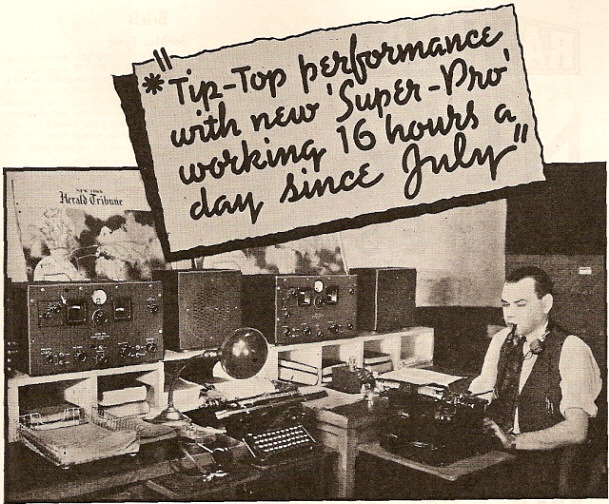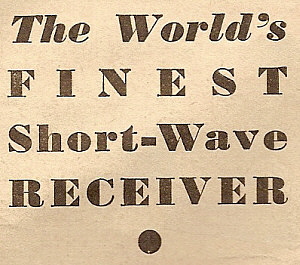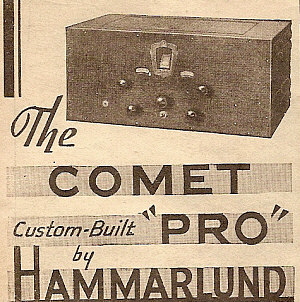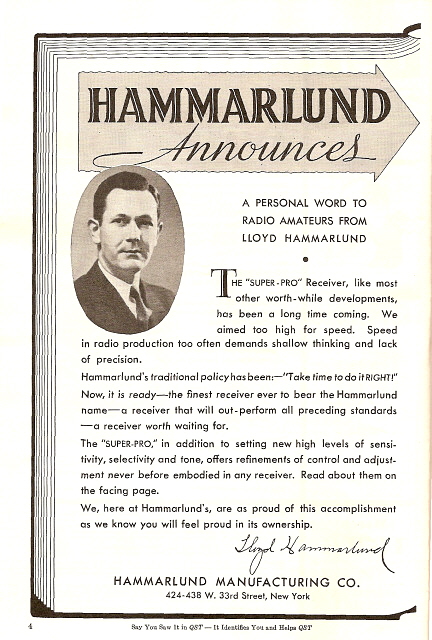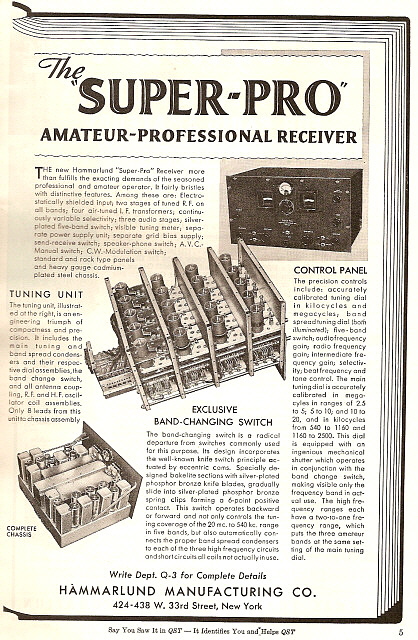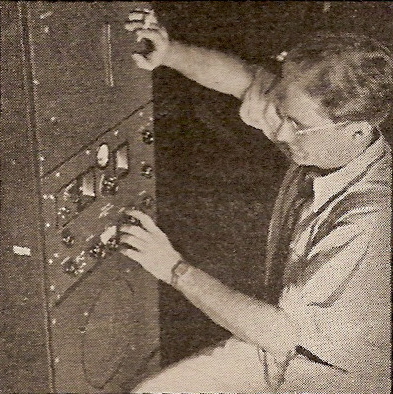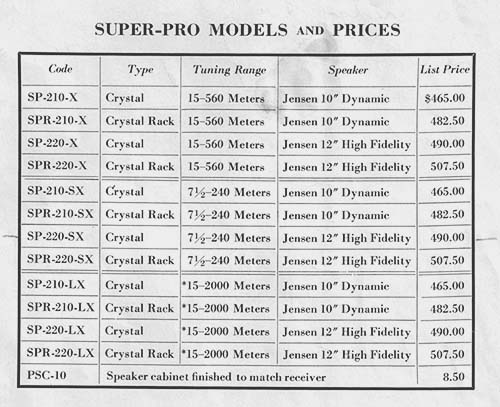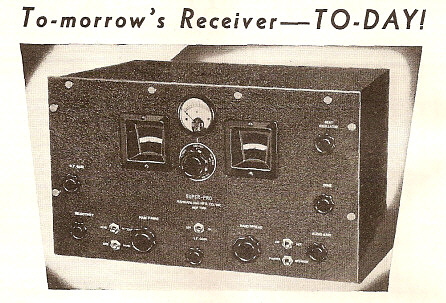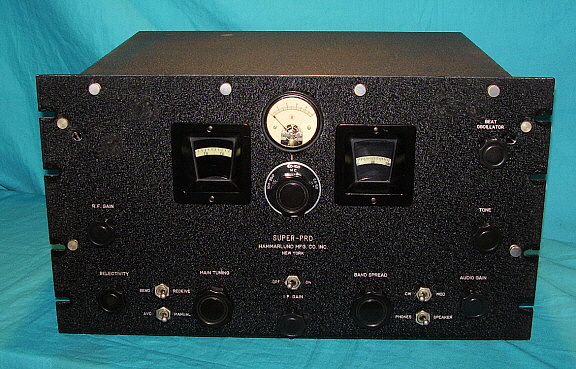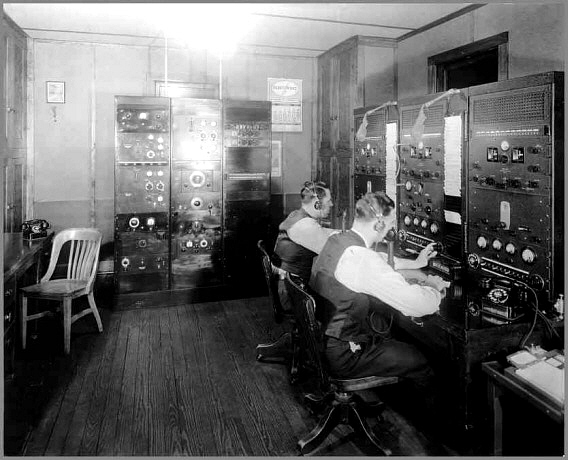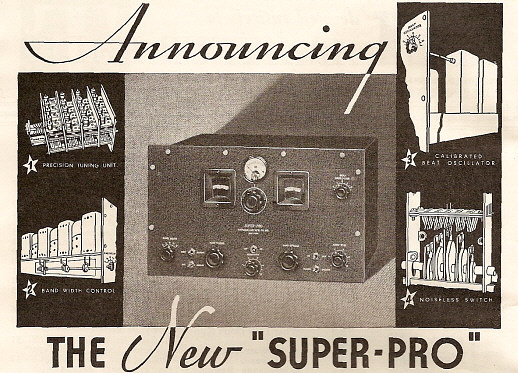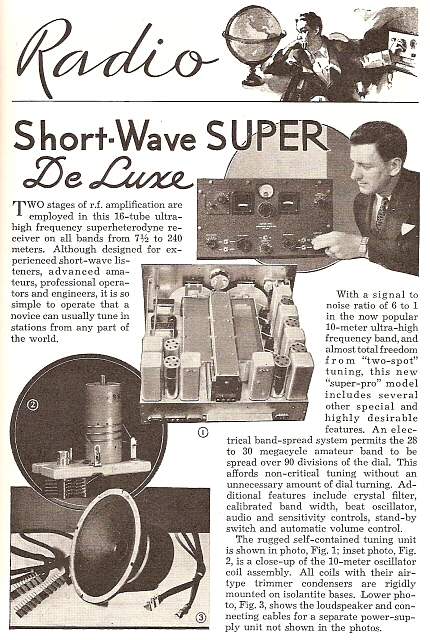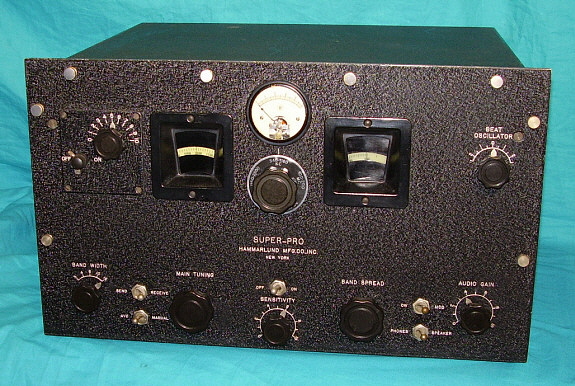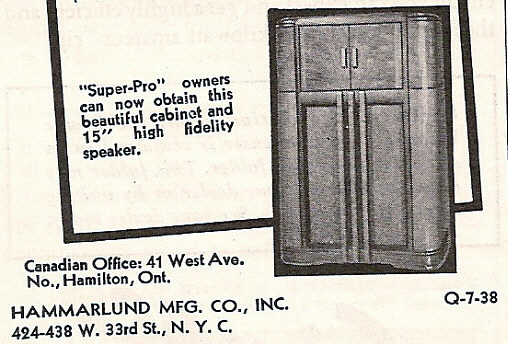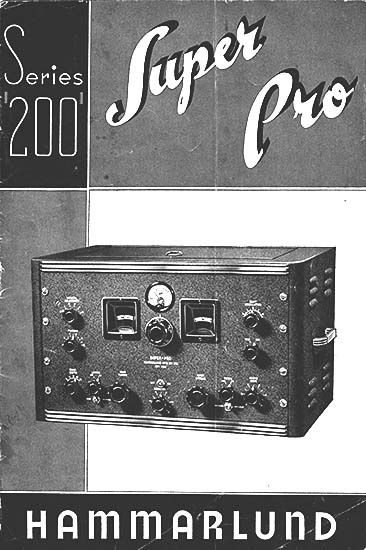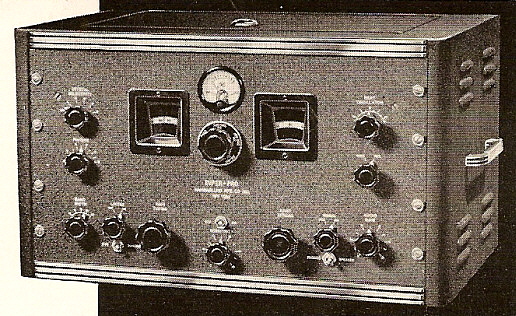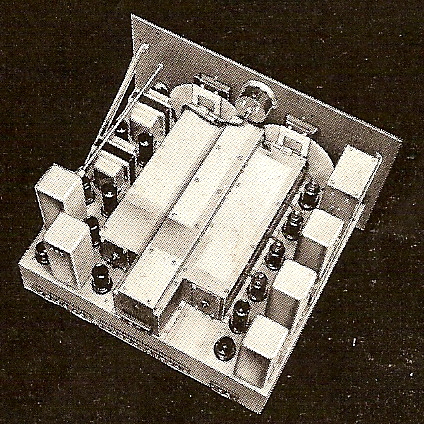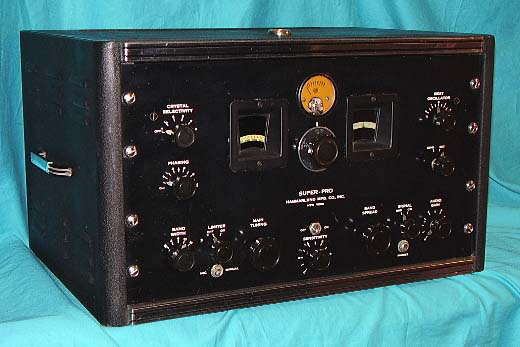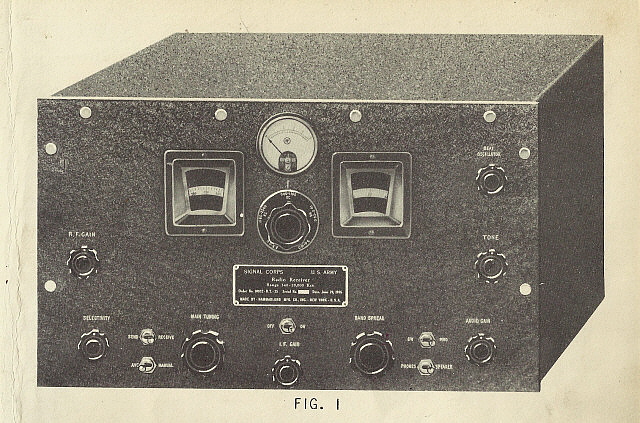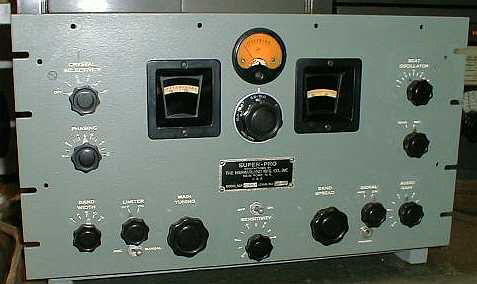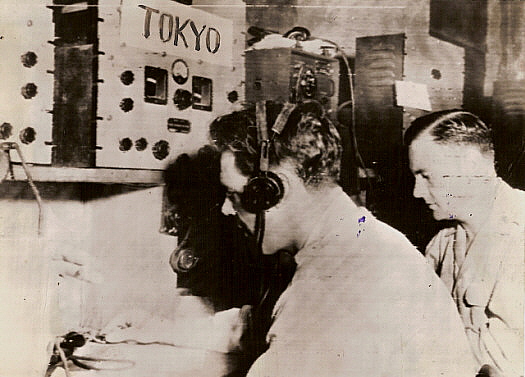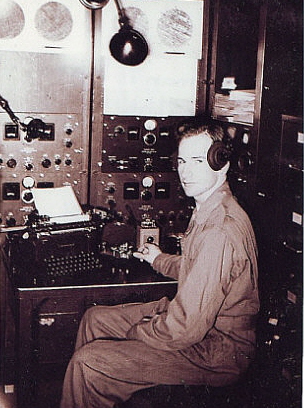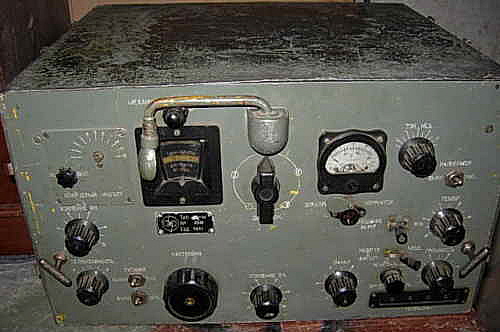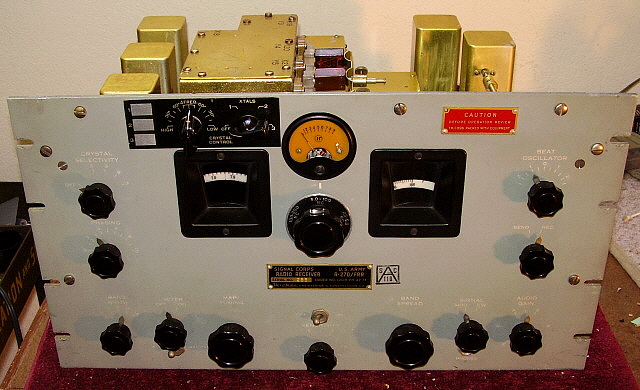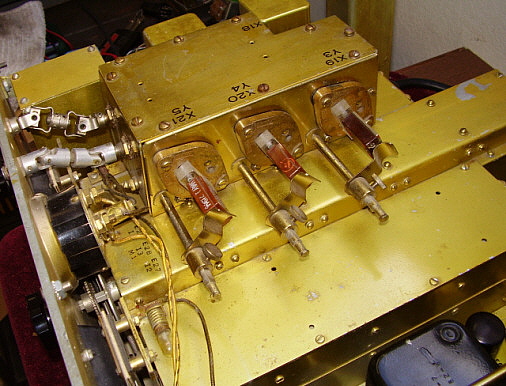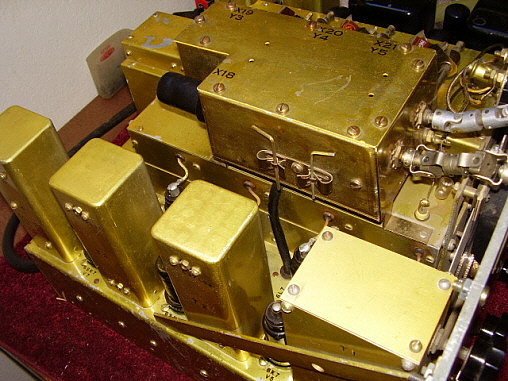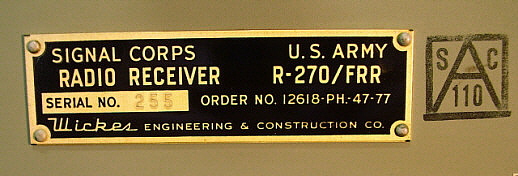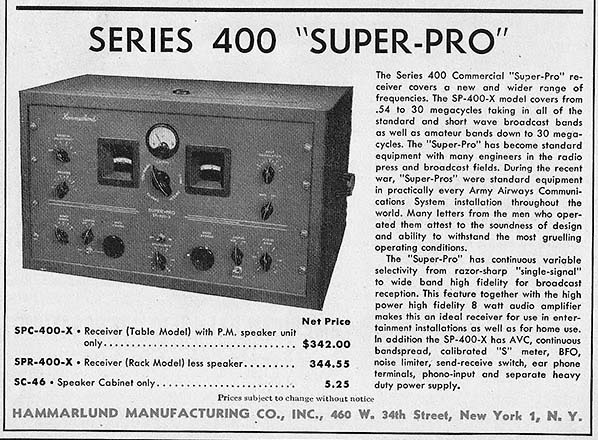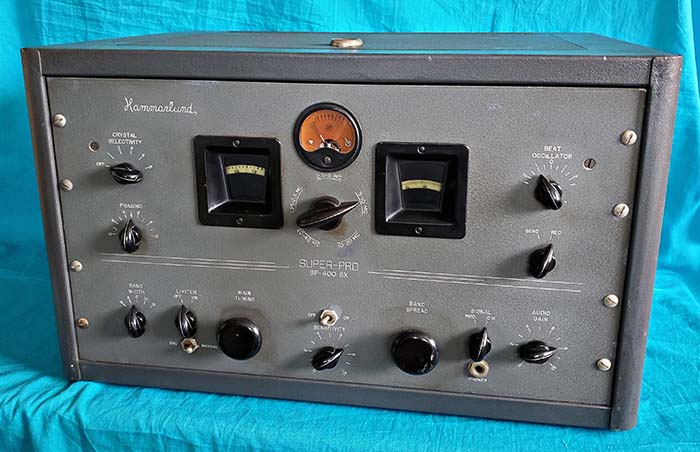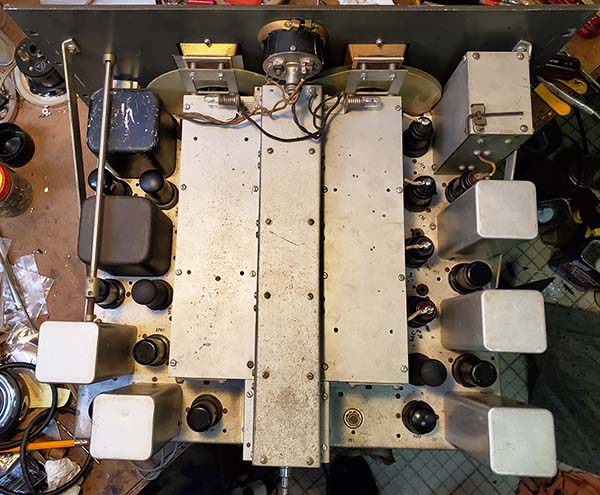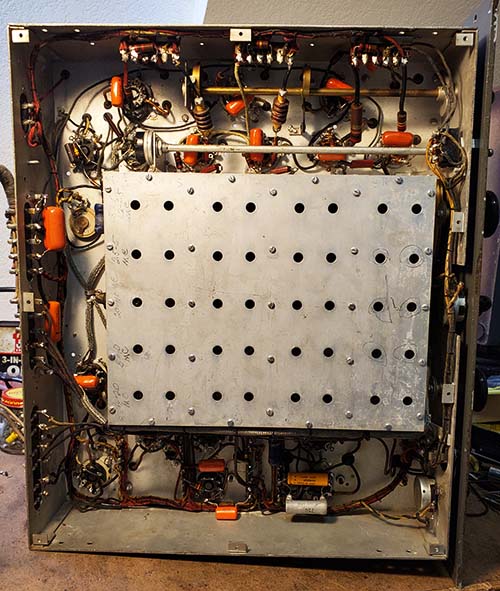|
All of the various power supplies that were built for the Super-Pro
are similar in design and similar in the voltages provided to the
various models of Super-Pro receivers. There were three levels of B+,
+385vdc, +270vdc and +140vdc that were specified for the SP-200 series.
The tube heater supply is 6.3vac and the C bias is -50vdc. The early
receivers, the SP-10 and the SP-100 used power supplies that provide
slightly lower B+ voltages with +365vdc, + 260vdc and +110vdc indicated
in the manuals. The bias voltage isn't specified in these earlier
manuals but it is in the range of -45vdc to -50vdc. All of the various
types of power supplies route the voltages to the receiver through a
four foot cable that has a ten spade lug connector that screws to the
ten pin terminal strips on both the power supply and the rear of the
receiver chassis. Usually the metal box, protective covers that mount
over the terminal strips on both the power supply and the receiver
chassis will be missing.
The SP-10 power supply used a type 1-V rectifier tube for the bias
supply. This tube was replaced in the SP-100 supply with a type 80
rectifier tube. The HV rectifier was a 5Z3 until about 1944. Late power
supplies will use a 5U4G and a 5Y3G rectifier tubes. Early power supplies
used with the SP-10 and SP-100 will have a small second
terminal strip with two screw connections marked "Field" for the electrodynamic
speaker that was provided with these receivers. With
some late SP-100 and all of the SP-200 power supplies, a large choke
with a DCR of 1100 ohms was included in the power supply to replace the
field coil of the electrodynamic speaker and allow the use of a PM
speaker. The standard power supply had
a metal box cover with louvers that protected the tubes. The power
supplies were usually placed on the floor near the
receiver. Rack mount power supplies have a 19" panel screw mounted to
the front of the chassis and a metal cover over the top of the chassis
with lugs the protrude out the front panel for the cap nuts. Bottom
covers were standard on all types of power supplies. Metal cup, felt
center feet are usually mounted at the corners of the bottom cover for
non-rack units. Some rack mount units will have the felt feet included.
|
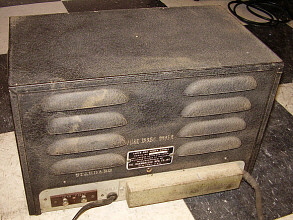
SP-100 PS SN:3388 - Note the two terminals for the field coil of
the electrodynamic speaker |
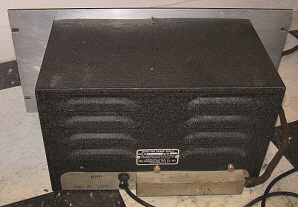
photo above: SP-200 PS Rack Mount - Note that the
terminals for the speaker field coil have been eliminated |
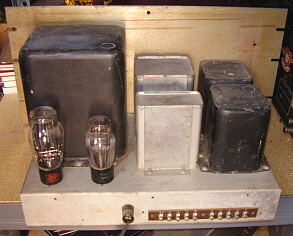
photo above: ASP-84B PS Military Rack Mount |
| Most of the military Super-Pro power supplies will have
an oversize potted power transformer and potted chokes with oil-filled
filter capacitors. Some of the late-version military supplies went to
can-type oil-filled paper capacitors. About this time the rectifiers were
changed to a 5U4G and a 5Y3G. All of the military supplies were normally
expected to operate in continuous duty service so the size of the power
transformer was substantially increased. Some of the military
power supplies will have dual primary power transformers for 115vac or
230vac operation. Military power supplies for the Signal Corps are
usually identified as RA-74, RA-84 or RA-94. RA-84 is for 115vac
operation only. The RA-74 is a heavy duty, multiple primary power supply and the RA-94 is
the heavy duty, dual primary power supply.
The SP-400 power supply is very similar to the non-military
versions of the SP-200 power supplies. Rectifiers used were the
5U4G and the 5Y3GT. Frame transformers and chokes are used.
Electrolytic filter capacitors are used. Output terminals and
power cable were not changed. Fortunately, almost any of the Super-Pro power supplies can
be used with almost any Super-Pro receiver. Considerations would
have to be made for the field coil connection on early supplies
but the voltage output terminals and the voltages present are
nearly the same for all power supplies and receivers. Care
should be taken when using a SP-200 power supply with either the
SP-10 or SP-100. The tubes used in the audio of the SP-10 are
42s and the SP-100 uses 6F6 tubes. The maximum plate voltage is
+375vdc on either type of tube. The SP-200 also used 6F6 tubes
and ran +385vdc at the connection terminals and assumed +380vdc
at the tube. But, the tube's maximum plate voltage is referenced to the
cathode voltage which is around +15vdc and that implies that the
plate-to-cathode voltage is around +365vdc which is fine. The
750 ohm cathode resistor didn't change in value in any of the
series so the increase from +365vdc in the early power supplies
to +385vdc in the SP-200 supplies was
probably viewed as a "safe" increase that resulted in slightly
more audio power. You can use a SP-200 power supply for testing
the SP-10 or SP-100 but for long-term operation of either type
of receiver, the correct power supply should be used. However,
it's
easy to modify a SP-200 supply by adding a 220 ohm 5 watt series
resistor in the +385vdc line to provide slightly lower Audio
Plate B+
voltage. The advantage
of always using a modified later power supply with either the SP-10 or SP-100 is
the elimination of the electrodynamic speaker requirement. These earlier
supplies utilized the field coil of the speaker as a filter
choke but later power supplies already have a choke installed so
a permanent magnet speaker can be used. The SP-200 power supply
can be used to power a SP-400 receiver with no modifications. |
|
Unfortunately, since just about any Super-Pro power
supply can be used with just about any Super-Pro receiver, very few
matched set-ups are found today - that is the sequentially serialized
receiver/power supply. With the SP-10 and SP-100 receivers, the original
power supply serial number is one off from the receiver serial
number. The assignment of a sequentially serialized power supply to a
specific receiver ended by the time the SP-200 was introduced in 1939.
The Super-Pro power cables normally encountered are
usually a nine wire, cloth covered cable with a special, spade-lug type
terminal strip connector on each end. These cables were used on the
later SP-200s and the military receivers. Some military power cables are
shielded and have rubber jacket insulation. Later nine wire SP-200
cables have tube heater wires that are of a larger gauge wire than the
remaining seven wires. The tenth lug is not used on these terminal
strips. On early cables, there are usually nine wires that are all the
same gauge. If a tenth wire is present, it is "switched to ground
(chassis) connection" that operates with the ON-OFF switch. It is not
used in the circuit as supplied but was provided as a spare function for
possible user applications. The switched ground operation is on most
Super-Pro receivers but the actual wire in the cable is seldom present
unless added by a former user. Many Super-Pros will be missing their
original power cable but the cables are easy to make. Just observe that
the tube heater connections, pins 1 and 2, use about 12 to14 gauge wires
while the remaining wires can be 16 to 18 gauge. The cable length is
approximately four feet. The connections to the
power supply match the receiver, 1 to 1, 2 to 2, etc. It isn't necessary
to have the terminal strip connectors but they do make connecting and
disconnecting the receiver and power supply much easier. The correct
orientation for an original power cable is to have the spade lugs
pointing down and the cable to exit the protective cover on the right
side.
photo right: The power cable from a military SP-200
Series Super-Pro receiver-power supply showing the unique spade-lug type
connector strip
|
 |
|
Hammarlund Super-Pro Serial Numbers and Estimated Production |
|
From examining many pre-WWII Super-Pro receivers along
with several HQ-120X receivers and Comet-Pro receivers, it appears that
Hammarlund issued serial numbers in a new sequence starting with "1" (or
some low number) beginning with the first SP-10 receiver and continuing
in sequence right through the military versions built during WWII. Since
the earlier Comet Pro receivers all have much higher serial numbers and
were all built before any Super-Pro receivers, they must have been
issued numbers from a different, earlier sequence. For example, a 1933
Comet Pro receiver with the SN: 7822 and a 1936 SP-10 with SN:576. It is
likely that all Hammarlund products that were going to be issued a
serial number were issued numbers from a common serial number roster.
Therefore all Super-Pro receivers were serialized sequentially as they
came off the line. It also appears that when the numbers were issued to
a Super-Pro "set," that receiver's power supply was issued the next
sequence number after the receiver's serial number. This is the case in
the two early matched sets that I know of. One is an SP-10, sn 720 and
PS sn 721. The second receiver, an SP-100X, sn 3387 and PS sn 3388. If
this was the normal Hammarlund practice, then each Super-Pro "set"
accounted for will use two numbers from the sequence - one for the
receiver and one for the power supply. There seems to be some SP-10 and
SP-100 sets that are "matched units" but are not sequential serial
numbers. The numbers are very close but not sequential. It was probably
standard procedure that a Super-Pro ordered from the factory would be
sent out with its sequentially numbered power supply. However, if one of
the many dealers got in a shipment of Super-Pro receivers and power
supplies, he might not be so careful to assure that a "matched" set be
provided to the purchaser. The matching of receiver and power supply
serial numbers accounting for the use of two sequential numbers from the
roster would hold true up to the time that the HQ-120X was introduced in
late 1938. It appears that the HQ-120X used the same serial number
roster as the Super-Pro "sets." After late 1938, the serial number
roster is split-up by Super-Pro receivers, SP Power Supplies and HQ-120X
receivers. By the time Hammarlund introduced the SP-200, the power
supply serial numbers were no longer sequentially assigned. When
Hammarlund starting to supply Super-Pros for the war effort (probably to
expedite production) no effort was taken to assure that certain power
supplies went with specific receivers. It is probable that specific
blocks of numbers from the roster were used for receivers and a
sequential block used for power supplies. This seems to be confirmed by
Super-Pro ASP-1004 SN: 27942 with matching power supply ASP-84B SN:
28870. A second ASP-84 serial number reported seems to be too early at
9686 but it may imply that the ASP SNs are a specific roster of numbers
(or the SN was reported incorrectly).
More ASP data will show whether this is the case. Speakers seem to have
an stamped-ink number but it appears that it may have been
identification numbers as sometimes different speakers are found with
the same numbers stamped inside. For now, we will assume that speakers
were not part of the serial number roster.
This use of sequential serial numbers issued to all
receiver products as they left the line makes estimating production
quantities very difficult. One has to take into account that lower
priced receivers, like the HQ-120X, sold in larger quantities than the
Super-Pro. Also, that the HQ-120X didn't appear until late 1938 and
therefore didn't affect the 1936 to 1938 Super-Pro serial numbers.
Additionally, the power supply serial number will divide the serial
number total by two for production totals for 1936 through most of 1938.
After the HQ-120X appears, a percentage must be factored into the serial
number total to extrapolate the Super-Pro production.
Without doubt, the SP-10 is a rare receiver. Very few
are ever encountered and from that one naturally concludes that
production was very low. It is likely that no more than 500 SP-10
receivers were built since it was only in production less than nine
months. With the SP-100, production goes from January 1937 up to about
August 1939, or about two years and eight months. Again though, the
SP-100 is rarely encountered. Production should be around 1000 receivers
because the HQ-120X has to be factored into the serial number use for
about the last year of SP-100 production. The SP-150 is so rare with
only 70 produced it is included with the SP-100 group. The pre-war
SP-200 is not a common receiver either. Probably only 1800 Super-Pro
SP-200 receivers were built before WWII began. With the WWII production,
the now commonly seen Super-Pro receivers are found. Production here was
around 10,000 receivers, perhaps more. Total Super-Pro production from
1936 up to 1945 should be around 14,000 receivers. Compare this to the
SX-28A production of around 11,000 receivers (not including SX-28
production) and a correlation can be seen as to how often any of the
pre-war and wartime Super-Pro receivers are seen versus how often an
SX-28A is encountered. The comparison seems valid.
One note,...the serial number on the military tag of all
BC Super-Pro receivers will not match the Hammarlund factory serial
number stamped on the rear of the chassis. The tag number was usually
assigned for the Signal Corps by Hammarlund for that receiver to be part
of a specific contract quantity. It will never match the chassis-stamped serial number
that was issued at the time of assembly. |
The following tables are rough estimates based
on serial numbers encountered weighed against quantity of receivers seen
and the assumed division of the serial number pool.
|
Serial Number Sequence with Estimated Production
Model
Serial Numbers Quantity Built
SP-10
Series....................1 up to ~1000........actual
receivers ~500
SP-100
Series..................1000 to ~4000.......actual receivers
~1200 (SNs shared with HQ-120X)
SP-200
Series (pre-war)...4000 to ~10000.....actual receivers ~1800
(SNs shared with HQ-120X)
SP-200
Military..............~10000 to 30000+....actual receivers ~
10000+
SP-400
Series.................... 4-0001 up to?....actual
receivers ?
|
Year to
Serial Number Table
SN Range
Year Models
1 to 1000 ........... 1936.......SP-10, PS
1000 to 3000.......1937.......SP-100, PS
3000 to 3800.......1938.......SP-100, PS,
HQ-120X
3800 to 5000.......1939.......SP-100, SP-200,
PS, HQ-120X
5000 to 8500........1940.......SP-200, PS,
HQ-120X
8500 to 10000......1941.......SP-200, PS,
HQ-120X
10000 to
14500......1942.......SP-200, BC series, PS, HQ-120X (RBG uses a
different format of SNs)
14500 to
19000......1943.......SP-200, BC series, PS
19000 to 25500......1944.......SP-200, BC series,
PS
25500 to
30000+....1945.......SP-200, BC series, PS |
|
|
Known Serial Number Log
This is a log of known and reported serial numbers for
all Hammarlund Super Pro receiver types made prior to the SP-600
receiver (Super-Pros from 1936 to 1948.) Also included are the SP power supplies
with "matched-pair" indicators where known. I've also included the HQ-120X
since it was serialized from the same number sequence as the Super-Pro
and those serial numbers do affect the total production quantity of
appropriate Super-Pro receivers. I've also included the military RBH/CHC-46140
out of curiosity. The Comet Pro receivers are included to show they were
serialized from a different sequence of numbers.
The
Super Pros are broken down into the various civilian models and the
three Signal Corps military versions. Likewise, the power supplies are
divided into civilian and military. Be sure to observe that the Signal
Corps tag on the front of the SP receiver has a Signal Corps serial
number and the receiver itself has a Hammarlund assigned serial number
stamped on the rear apron of the chassis. The Hammarlund assigned serial
number is what we are logging. Note that the SP-400 serial numbers are
using a different format with one digit, a hyphen followed by four
digits.
|
SP-10: 575, 576, 674(ps 804),
720(ps 721), 913, 979(ps 987), 1023, 1110,
SP-100: 1352*, 2562(ps 2612),
2564(ps 2615), 2570, 2672(SX), 2714,
2730(LX), 2746(ps 2785), 3356,
3387(ps 3388), 3417(ps 3400), 3665(LX-ps 3649) 3826,
4106(LX), 4475(LX),
SP-150: 3055(ps 3105),
SP-200X: 4121, 4227, 4239, 4833, 4912,
4955, 5580, 5658, 6005(ps 6056), 6045, 6239(ps 6215),
7060(SC), 7334, 7853, 8295, 9419, 10664, 14910(ps 15204), 16135,
SP-200SX: 4146, 4289, 5226, 6230, 6289(ps 6331),
9759, 15775(ps 14653)
SP-200LX: 6776, 6884, 6965, 7353, 7381, 7545, 8023,
8423, 8466, 9262
SP-200X - Special: - 5733, 5858,
BC-779 (incl. Howard:) 6530H, 6873H, 7416H,
9030H, 9828, 11162H, 12421, 23688, 25298 BC-794: 19828, BC-1004: 18320, 21009,
27942(ASP-1004),
R-129/U:
|
Super-Pro PS CIV: 3545(100), 4215B (200), 4287, 5164,
7036(200SC), 9238(200), 11184, 11865 Super-Pro PS MIL: 5514H (ASP-84), 9686(ASP-84), 17656(RA-94),
17783(RA-94), 21186(794), 22093(1004), 26595(RA-74),
28870(ASP-84)
HQ-120X: 7007, 7244, 7408, 7711, 9630,
9881,
RBG/CHC-46140: 519(RBG-2), 524(RBG-2), 982(RBG-2), 1473(RBG-2),
SP-400-X: 4-2683(ps 4-2200),
SP-400-SX: 4-1249(ps 4-1038), 4X2566,
Comet All Wave: 1006
Comet Pro: 7531, 7822, 8001, 8079 |
NOTE:
Sequential or close (matched-with receiver) serial numbered power
supplies are listed in () along with receiver SN
* = variation of standard model SP-10 or SP-100 (SP-200 listed as
Special)
(Howard) = BC-779 receivers built by Howard Radio Co. as a
contractor during WWII will have "H" suffix in serial number
(Howard also built BC-1004 receivers)
(Special) = SP-200 Receiver with special frequency coverage or
other non-standard features
(SC) = Signal Corps - military contract
model |
|
|
Super-Pro
Serial Numbers Needed
Since it appears that all Super-Pro receivers and their
power supplies along with the HQ-120X receivers were serialized from a
common serial number roster, any serial number from any of these
Hammarlund products provides important information as to production
quantity and date lines. Even the earlier Comet Pro serial numbers
should show that it used a different set of numbers. If you have one or
more pre-war Super-Pro receivers, SP power supplies, HQ-120X, RBG,
SP-400 or Comet
Pro receivers, please e-mail the serial number and what model it goes
with to Western Historic Radio Museum. I'm just starting to log
serial numbers (Aug2019) for the SP-400 receivers. The SP-400 serial
numbers use a different format but as
more SNs are logged it may show some connection to the earlier model
serial numbers. Be sure if your Super Pro
is a military version to send the Hammarlund serial number stamped on
the rear of the chassis not the serial number on the ID tag. We will
add the information to the Known Serial Number Log. With each number,
more knowledge is gained about these incredible receivers and that
information will be added to this website. Hopefully the result will be
an on-line accurate source of information about the pre-war Super-Pro
receivers.
e-mail Super-Pro info to:
WHRM-SUPER-PRO
SERIAL NUMBERS |
|
